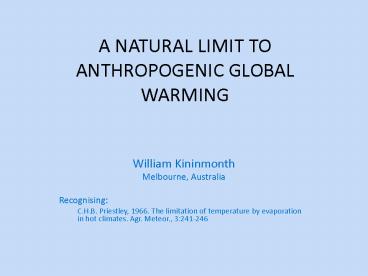A NATURAL LIMIT TO ANTHROPOGENIC GLOBAL WARMING - PowerPoint PPT Presentation
1 / 15
Title:
A NATURAL LIMIT TO ANTHROPOGENIC GLOBAL WARMING
Description:
balance at the Top of the Atmosphere (TOA) ... ERBE zonal mean net radiation (W m2) for Feb 1985 Apr 1989. Trenberth and Caron, 2001 ... – PowerPoint PPT presentation
Number of Views:52
Avg rating:3.0/5.0
Title: A NATURAL LIMIT TO ANTHROPOGENIC GLOBAL WARMING
1
A NATURAL LIMIT TOANTHROPOGENIC GLOBAL WARMING
- William Kininmonth
- Melbourne, Australia
- Recognising
- C.H.B. Priestley, 1966. The limitation of
temperature by evaporation in hot climates. Agr.
Meteor., 3241-246
2
Assumptions of the AGW Hypothesis
- Prior to industrialisation there was global
average radiation - balance at the Top of the Atmosphere (TOA)
- Radiation Forcing by anthropogenic
greenhouse gases is the - global average reduction in upward directed
infrared - radiation at the tropopause
- There is a direct relationship between
Radiation Forcing, ?Fu - and surface temperature increase, ?Ts
- ?Fu ? ?Ts
- Seemingly plausible but not verified
3
- Anthropogenic emissions of carbon dioxide to the
atmosphere change the infrared (IR) radiation - Reduced IR radiation to space in CO2 band
- Increased IR back radiation at the surface
(Kiehl and Trenberth 1997)
4
- There is very little change in Infrared Radiation
Loss - from the Atmosphere as CO2 concentration changes
- IR to space decreases
- IR back radiation to surface increases
5
There is no local radiation balance at the top of
the atmosphere
Excess Solar Radiation
Excess IR to Space
6
Climatology of Radiation to Space- dominated by
cloud and moisture distribution
7
Carbon dioxide increases surface back radiation
- The surface temperature rises, and
- Surface radiation emission increases
- Latent energy exchange increases
- (Earths surface 70 percent ocean)
8
Back IR radiation forcing, ?FCO2 causes a surface
temperature response, ?Ts
?FCO2 dFu/dT dLH/dT - dFd/dT
?Ts where ?Ts the change in surface
temperature due to an increase in back infrared
radiation ?FCO2 from increased CO2
concentration dFu/dT the rate of increase in
surface emission of infrared radiation with
temperature dFd/dT the rate of increase in
back infrared radiation with temperature at the
surface dLH/dT the rate of increase of latent
energy exchange between the surface and
atmosphere with temperature.
9
- The Radiation Forcing equation can be re-arranged
to give - ?Ts ?TCO2 / (1 r)
- ?TCO2 the direct surface temperature change
- without feedbacks due to CO2 forcing
- ?TCO2 ?FCO2/ dFu/dT dLH/dT
- 1 / (1 r) the feedback amplification of surface
- temperature
- r dFd/dT/dFu/dT dLH/dT
- Note
- The rate of increase of surface energy loss with
temperature - dFu/dT dLH/dT constrains both the direct
surface temperature response to Radiation Forcing
and the feedback amplification - Latent heat exchange is an important component of
the constraint
10
Variation of surface energy exchange
components with temperature (constant CO2
concentration)
Surface IR emission (Fu)
Back IR at the Surface (Fd)
Net surface IR Loss (Fu Fd)
Surface Latent energy exchange (LH) dLH/dT
7C-1
11
The Earths Global Mean Surface Temperature is
stable (constant CO2)
Surface Energy Loss
Solar and Reservoir Exchange
12
Surface Temperature Change with Double Carbon
Dioxide
Surface Energy Loss dLH/dT 6C-1
13
Computer Models underestimate the rate of global
evaporation increase with temperature
Computer Models exaggerate surface temperature
increase with anthropogenic emissions of CO2
Enhanced Surface Temperature Rise 1.5oC
14
Sensitivity of Surface Temperature to Evaporation
?Ts ?TCO2 / (1 r) ?TCO2 ?FCO2/ dFu/dT
dLH/dT 1 / (1 r) 1/(1 dFd/dT/dFu/dT
dLH/dT) dFu/dT 5.4 Wm-2C-1 (Stefan
Boltzman) dFd/dT 4.8 Wm-2C-1 (MODTRANS)
15
Summary
- CO2 affects global temperature through its
increase in back radiation at the surface AGW
is real - Water vapour amplifies the CO2 forcing by a
factor of two - Increased rate of latent energy exchange with
temperature constrains the surface temperature
response from 2xCO2 forcing to about 0.6oC - GCM used in the IPCC Fourth Assessment
underestimate the rate of increase in latent
energy exchange with temperature and grossly
exaggerate the surface temperature response to
CO2 forcing. - AGW is real but at 0.6oC for 2xCO2 is not
dangerous

